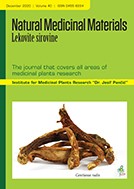Department of Chemistry, Technology and Metallurgy, University of Belgrade , Belgrade , Serbia
Department of Chemistry, Technology and Metallurgy, University of Belgrade , Belgrade , Serbia
Faculty of Chemistry, University of Belgrade , Belgrade , Serbia
Dept. of Plant Physiology, Institute for Biological Research “Siniša Stankovic” , University of Belgrade , Belgrade , Serbia
Institute for Medicinal Plant Research “Dr. Josif Pančić” , Belgrade , Serbia
Faculty of Agriculture, University of Belgrade , Belgrade , Serbia
Department of Chemistry, Technology and Metallurgy, University of Belgrade , Belgrade , Serbia
This study represents a continuation of exploring of the biological activities of the Artemisia santonicum essential oil. The previous investigation was focused on the antibacterial, antibiofilm, and antiquorum activities of A. santonicum essential oil and isogeranic acid as the main antibacterial constituent. The present study describes their antifungal activity. The antifungal activity of the A. santonicum essential oil was tested against eight fungi isolates, whereas antifungal effects of isogeranic acid were studied using four fungi species, because of the limited quantities of the isolated compound. The results were compared to the commercial antimycotics, bifonazole and ketoconazole. Antifungal activity of isogeranic acid against all tested fungi was significantly higher in comparison to the essential oil and the both controls.
This is an open access article distributed under the Creative Commons Attribution License which permits unrestricted use, distribution, and reproduction in any medium, provided the original work is properly cited.

The statements, opinions and data contained in the journal are solely those of the individual authors and contributors and not of the publisher and the editor(s). We stay neutral with regard to jurisdictional claims in published maps and institutional affiliations.